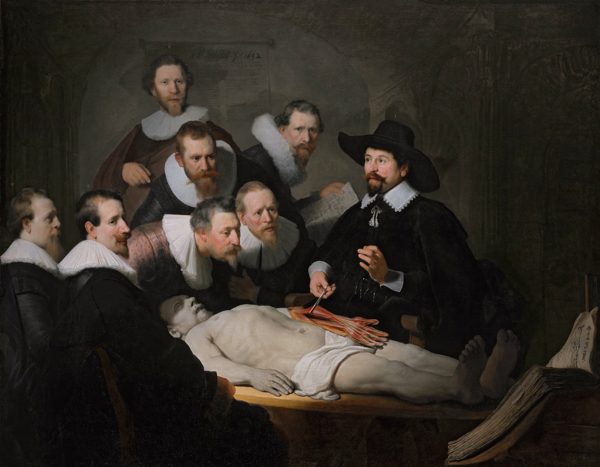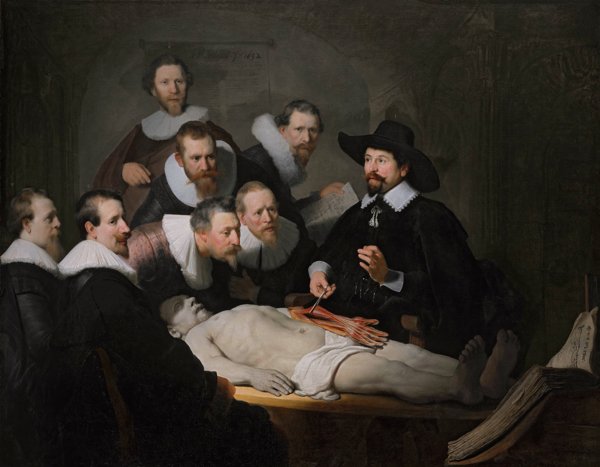The Master’s “Mistake”
By Rebecca McGraw Thaxton, M.D., WTP Guest Writer

 I am a general practitioner and my husband is a surgeon. One morning at breakfast I placed a picture of Rembrandt’s “Anatomy Lesson” in front of him and said, “What do you think?”
I am a general practitioner and my husband is a surgeon. One morning at breakfast I placed a picture of Rembrandt’s “Anatomy Lesson” in front of him and said, “What do you think?”
His eyes went immediately to the dissected forearm, and he reflexively said, “The anatomy’s wrong.”
Way back when I was in med school, I of course had anatomy lab. When I dissected the arm during an anatomy lesson, as my husband duly noted, the anatomical findings were not as Rembrandt’s widely known painting inaccurately—in fact, quite wrongly—depicts.
In 2006, a Dutch plastic surgery department re-enacted this dissection and concluded that the Master had erred. Besides my surgeon husband, other plastic surgeons and orthopedist colleagues alike whom I’ve independently surveyed agree, yes, the anatomy in that painting is indubitably wrong. Our state’s orthopedic association discussed the error at their annual meeting one year, according to one friend and orthopod, and further details of their discussion become pertinent later. But for now, the point is that Rembrandt painted the arm and hand anatomy wrong.
And hands are not neutral. One paragraph into the hand section of my med school anatomy book, I remember reading this: “We pray with our hands and communicate with them. We use them to eat, work, and make love. We employ them as marvelously sophisticated instruments of flexibility and strength, and when they are damaged, we anguish.” Physically speaking, the human hand is a myriad of moving, living parts, a machine of exquisite balance between stability and movement, this minute balance necessary for its finer movements.
Andreas Vesalius, Renaissance physician and anatomist, wrote the fundamental anatomy book, De humani corporis fabrica libri septem, in the sixteenth century, over one hundred years before Rembrandt painted “The Anatomy Lesson.” In a famous image from the book— and one that is anatomically correct—Vesalius is portrayed with the dissected upper extremity, an age-old statement as to the prestige of the hand.

And this dissected left arm in Rembrandt’s “Anatomy Lesson” is, of course, much (like in the woodcut) a focal point of the image. It is a visual and thematic centerpiece. In stark contrast, however, it is an inaccurate depiction, and herein lies the conspicuous error of this painting. In his Physics and Reality, Einstein said, “The most incomprehensible thing about the universe is that it is comprehensible.” Along that line, in my husband’s medical library alone, I counted fourteen volumes on the hand. And I could explain the mechanization that is the human hand ad nauseam, even have a layperson feel their very own flexors as they course and contract through their forearm, to comprehend their anatomy with a “yes, I see.” I find the very title of Vesalius’s work pertinent— De humani corporis fabrica libri septem, which is Latin for, On the Fabric of the Human Body in Seven Books. The fabric—ah, that word in this context appeals deeply to both the writer and the doctor in me. As the word suggests, the physical fabric of the human body is set. The fabric is stagnant. This mistake in the physical fabric of the anatomy in this painting is clear and heralding, at a glance, to experts almost four hundred years later. But why? Why did Rembrandt make such a flagrant mistake? Well, that is a question forever left up in the air. And that is my particular and unfortunate obsession with this painting.
To answer the question of why, maybe we first have to ask was this an accident or did Rembrandt err on purpose? Given the context of the piece and Rembrandt’s mastery, and the issue that the hands are paramount to the meaning of the piece, it was not likely an accidental mistake. For instance, Vesalius’s Seven Books contained Vesalius’s own portrait with obvious detail of none other than a dissected upper extremity. It has even been postulated that the book at the foot of the table in The Anatomy Lesson was Vesalius’s Seven Books. A Master such as Rembrandt probably knew correct forearm anatomy.
What might shed light is to explain what is known about the painting. Much early art recorded current events. This painting depicted a current event. In Holland in 1632 (the year of the painting), human dissections were public spectacles. Observers paid an entry fee to attend them; they often consumed food and wine at these events. In the subject of the painting, eight men were gathered around the dissection table, in front of an audience in a dissection theatre. Dissections then and now began not with the forearm, but with the thorax, for obvious reasons—timing; the abdomen rots first. So even this detail of which body part to flay was chosen.
The story of the dissection is that the cadaver was Adriaen het Kint; het Kint was another word for “the kid.” He was a thief. His punishment for thievery included that his right hand was chopped off, and then he was executed by hanging approximately two hours before this dissection. In fact, Rembrandt initially painted this work minus het Kint’s right hand. The artist later went back and added it. The right hand is dark and discolored compared with the rest of the right upper extremity. It is also notably out of normal anatomical proportion; the fingertips reach the hip, not the thigh. In this way, there is attention drawn to the hand(s) here. Indeed, there is an entire chain of hands that begins here, with that right hand of the dead thief. Any way you slice it, there are five hands in that chain, the first two belonging to the lowest member of the painting, the thief, the next two to its highest member, the doctor.
As I mentioned earlier, my state’s orthopedic society discussed the painting at their annual meeting. One of their hypotheses was that perhaps Rembrandt used the cut-off right upper extremity as a model and just wrongly and accidentally transposed it as the dissected left arm in the painting. The problem with this idea is that the tips of the dissected fingers are clearly flexed. This would not have been so with a dissection of the back of the right arm. The flexors are on the ventral side of the arm, the front, so to speak. This still supports the case that the error was purposeful.
The anatomy of any hand dissected during the Renaissance or in 1632 or when I was in med school or now stays the same. The fabric of the complicated and miraculous hand remains static. Ropes, pulleys, levers, planes. Good old living, comprehensible machinery. While the details of the mechanism of the hand were difficult and time consuming to memorize for me as a first-year med student, they were straightforward. What is not straightforward is the reason why Rembrandt painted this anatomy as such. Did it have anything to do with the thief’s fate for stealing? If so, should it have? These things are not straightforward. Not now, not four hundred years ago. This is timelessness. This is art.
“The anatomy’s wrong,” my husband had stated, succinctly, and without doubt, like a surgeon. But “Why?” I still ask, with unending doubt, unable to explain this with such enviable certainty. Which brings me back to my unfortunate obsession with the painting and why it is unfortunate. It is so simply because I can never know for sure. As a doctor, given enough time to do so, I can explain the concrete form and function of the hand, intricate and complicated as it may be. As a writer, though, I cannot explain the painting, the endurance of it, the error, the reason, the mystique. This is a complicatedness that keeps going, that is…incomprehensible, perhaps. And as Einstein also said, not everything that counts can be counted.
So whether Rembrandt’s was an accidental error or a purposeful one, and if so, “why,” are perhaps questions forever left up in the air—and maybe that’s OK. Nearly four hundred years later, we are left to wonder, and we do. But in our wondering, we still revere the painting. We protect it and preserve it. We visit it, and we recognize it. The unanswered questions finally prove an enduring source of tension. And it is exactly this tension, the unanswered, the not-so-clear and spelled out and obvious, that perhaps is the very component of lasting and great art.
Z. Shuff holds an MD and an MFA, and works as a physician in West Virginiat. Her medical writing has appeared in various medical journals. She has lectured on art at a national medical conference and at her MFA program. Her work has appeared in Poetry Quarterly, Fifty Word Stories, Blink-Ink, Flash Fiction Magazine and Literally Stories.

